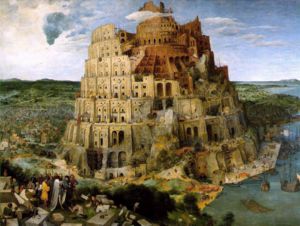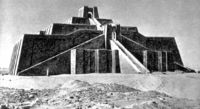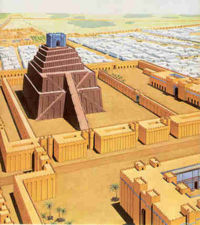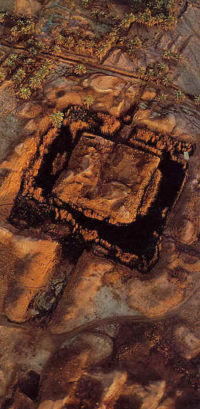
The Tower of Babel (Hebrew: מגדל, mighdal) was the lofty structure built by the descendants of the Flood survivors according to Genesis 11:1-9 , "whose top may reach unto heaven."
The Tower of Babel account provides an explanation to fundamental mysteries that atheistic science has been unable to solve: the different languages today that lack a common origin, and the immense diversity in ethnicity.
Contents
- 1 Biblical account
- 2 The Meaning of “Babel”
- 3 General Form of Babylonian Temple-Towers
- 4 Location
- 5 The Builders of the Tower
- 6 The Ultimate Destruction of the Tower
- 7 Other Non-Biblical references
- 8 Brick and Stone significance
- 9 Linguistic evidence
- 10 See also
- 11 Further reading
- 12 References
- 13 External links
Biblical account[edit]
The Tower of Babel is first mentioned in the Book of Genesis as the first great rebellion by mankind after the Flood; instead of spreading across the earth, they settled together in the land of Shinar and built a city and a great tower out of baked bricks in order to make a name for themselves:[1]
- And the whole earth was of one language, and of one speech.
- And it came to pass, as they journeyed from the east, that they found a plain in the land of Shinar; and they dwelt there.
- And they said one to another, Come, let us make brick, and burn them thoroughly. And they had brick for stone, and bitumen had they for mortar.
- And they said, Come, let us build us a city and a tower, whose top may reach unto heaven; and let us make us a name, lest we be scattered abroad upon the face of the whole earth.
- And the LORD came down to see the city and the tower, which the children of men built.
- And the LORD said, Behold, the people are one, and they have all one language; and this they begin to do: and now nothing will be restrained from them, which they have imagined to do.
- Come, let us go down, and there confuse their language, that they may not understand one another's speech.
- So the LORD scattered them abroad from there upon the face of all the earth: and they left off building the city.
- Therefore is the name of it called Babel; because the LORD did there confuse the language of all the earth: and from there did the LORD scatter them abroad upon the face of all the earth. (Genesis 11:1-9, King James Version)
The Meaning of “Babel”[edit]
The Tower was built in Babylon, on account of the confusion of languages. The word is based purely on the Hebrew etymological law, which makes bālal, “to confuse,” or “mingle,” assume a reduplicate form; but as far as the numerous cuneiform inscriptions are concerned, balālu, “to mingle” (the root in question), was an impossibility. On the Babylonian side the rendering of the name Bâb-îli (-îlāni), “gate of god” (or “of the gods”) was a folk-etymology, sharing the same meaning as the Sumero-Akkadian form Ka-dingira. It is noteworthy, however, that one of the forms used by Nebuchadrezzar is Babilam, with the mimmation or “emming,” which is a characteristic of the Babylonian language; moreover, a place-name Babalam also occurs, which may be a still earlier, and possibly the original, form. Notwithstanding that one would like to see in Babalam, “the place of bringing together,” and in Babilam, “the bringer together,” the termination -am would seem to be an insurmountable difficulty.
General Form of Babylonian Temple-Towers[edit]
There was a great difference, however, between the mighdōl or watchtower, and the great Tower at Babylon. The watchtower was simply a high structure, probably without any special shape or form, which depended upon the will of the architect and the nature of the ground upon which it was erected. The Tower of Babel or Babylon was a structure peculiar to Babylonia and Assyria. According to ancient accounts as well as judging from the ruins of the various remains extant in those countries, Babylonian temple towers were square or rectangular in shape; they were built upward in stages, and provided with a stairway along each side to the top. These structures were finished with a small temple at its peak for religious ceremonies.
These buildings were called by the Babylonians ziqqurātu (Modern English: "ziggurat"), apparently meaning “peak,” or the highest point of a mountain; this word being applied to the mountain-height upon which Ut-napishtim, the Babylonian Noah of the Gilgamesh saga, offered sacrifices on coming forth from the ark (or ship) when the waters of the great Flood had sufficiently subsided. It has also been conjectured that they were used as observatories when the Babylonians studied the starry heavens. This is probable, but as the ziggurats were of no great height, it is possible that in the clear atmosphere of the Babylonian plains there was no real necessity to go above the surface of the earth when making their observations.
Location[edit]
There has been much difference of opinion as to the geographical position of the Tower of Babel. Most writers upon the subject, following the tradition handed down by the Jews and Arabs, have identified it with the great Temple of Nebo in the city of Borsippa, now called the Birs-Nimroud (explained as a corruption of Birj Nimroud, “Tower of Nimrod”). Although an important religious structure to the Babylonians, it was never regarded by them as the actual tower. The great tower they referred to was located within Babylon and called Ê-temen-ana-ki, “the Temple of the foundation of heaven and earth,” called by Nabopolassar and Nebuchadrezzar ziqqurat Bâbîli, “the Tower of Babylon” - the world-renowned temple dedicated to Merodach and his consort Zēr-panîtum, Babylon's chief deities.
Its Position at Babylon[edit]
This structure was situated in the southern portion of the city, not far from the right bank of the Euphrates, and is now represented by a depression within which is the original rectangular core of unbaked brick. From its shape the Arabs have called this site Sahan, “the dish,” as the bricks of the structure (unlike other ziggurats which were built of dried mud-brick, Etemenanki was built of fired brick) were stripped in favor of other structures or to repair the banks of the Hindiyeh canal.
Babylonian Description of the Tower[edit]
Etemenanki consisted of six stages built upon a platform, and provided with a sanctuary at the top. A tablet seemingly giving a detailed description of this building was for a time in the hands of archaeologist George Smith in 1876; however he had not time to give a translation of the document or to publish the text, but his detailed account of it (Athenaeum, February 12, 1876) is exceedingly interesting.
First there was the outer court called the “grand court,” measuring, according to Smith's estimate, 1,156 ft. by 900 ft., and a smaller one, called “the court of Ishtar and Zagaga,” 1,056 ft. by 450 ft. Round the court were six gates admitting to the temples: (1) The grand gate; (2) The gate of the rising sun (east); (3) The great gate; (4) The gate of the colossi; (5) The gate of the canal; and (6) The gate of the tower-view.
Platform[edit]
After this came a space or platform apparently walled - a ki-gallu square in form, and measuring 3 ku each way. Its size is doubtful, as the value of the ku is unknown. The sides of this enclosure faced the cardinal points. In its walls were four gates, one on each side, and named from the points toward which they looked. Within this enclosure stood a large building measuring 10 gar (according to Smith, a gar is 20 feet; 10 gar = 200 ft.) each way. Unfortunately, the name of this structure was damaged, so that its nature and use are uncertain.
Chapels and Shrines[edit]
Round the base of the Tower were small temples or chapels dedicated to the various gods of the Babylonians. On the East were 16 shrines, the principal of them being dedicated to Nebo and Tašmêtu, his spouse; on the North were two temples dedicated to Êa. (Aê) and Nusku respectively; on the South was a single temple to the two great gods, Anu and Bel (Enlil?). It was on the West, however, that the principal buildings lay - a double house with a court between the wings 35 cubits (Smith: 58 ft.) wide. These two wings were not alike in dimensions, the structure on one side being 100 cubits by 20 (166 ft. by 34 ft.) and on the other 100 cubits by 65 (166 ft. by 108 ft.). In these western chambers stood the couch of the god, and the golden throne mentioned by Herodotus, with other objects of great value. The couch was stated to have measured 9 cubits by 4 (15 ft. by 6 feet 8 inches).
The First Stage[edit]
In the center of these groups of buildings stood the great Tower in stages, called by the Babylonians “the Tower of Babel” (ziqqurat Bâbîli). The stages decreased from the lowest upward, but each was square in plan. The first or foundation-stage was 15 gar each way by 5 1/2 gar high (300 ft. by 110 ft. high), and seems to have been decorated with the usual double recesses which are a characteristic of Assyr-Bab architecture.
The Remaining Stages[edit]
The second stage was 13 gar square and 3 gar high (260 ft. by 60 ft.). A term was applied to it which Smith did not understand, but he notes that it probably had sloping sides. The stages from the 3rd to the 5th were all of equal height, namely, 1 gar (20 ft.), and were respectively 10 gar (200 ft.), 8 1/3 gar (170 ft.) and 7 gar (140 ft.) square. The dimensions of the 6th stage were omitted, but may be restored in accordance with the others, namely, 5 1/2 gar square (110 ft.) by 1 gar (20 ft.) high.
The Chapel at the Top[edit]
On this was raised the 7th stage or the upper temple or sanctuary of the god Bel-Merodach, 4 gar long, 3 1/2 gar broad and 2 1/2 gar high (80 ft., 60 ft., and 50 ft., respectively). Smith did not mention the statue of the god, but it was conjectured that the chapel did contain one. The total height of the tower from foundation to chapel was 15 gar (300 ft.), the same as the breadth of its base. It cannot be said that it was by any means a beautiful building, but there was probably some symbolism in its measurements, and in appearance it probably resembled (except the decoration) the temple tower of Calah as restored in the frontispiece to Layard's Monuments of Nineveh, 1st series, in which a step-pyramid with a similarly highbasement stage is shown.
Herodotus' Description[edit]
The description of the tower as given by Herodotus agrees. He states that it was a temple square in form, two furlongs (1, 213 ft.) each way, in the midst of which was built a solid tower a furlong square (nearly 607 ft.). This, however, must have been the platform, which, with the six stages and the chapel on the top, would make up the total of eight stages of which Herodotus speaks. The ascent by which the top was reached he describes as running “outside round about all the towers” - wording which suggests, although not necessarily, that it was spiral in design - i.e. one had to walk round the structure 7 times to reach the top. Representations on Babylonian boundary-stones suggest that this view would be correct, though a symmetrical arrangement of inclined paths might have been constructed which would have greatly improved the design. At the middle of the ascent, Herodotus says, there was a stopping-place with seats to rest upon, which rather favors this idea. At the top of the last tower there was a large cell, and in the cell a large couch was laid, well covered; and by it a golden table. There was no image there, nor did any human being spend the night there, except only a woman of the natives of the place chosen by the god, “as say the Chaldeans who are the priests of this god.” These men told Herodotus that the god often came to the cell, and rested upon the couch, “but,” he adds, “I do not believe them.” After mentioning parallels to this at Egyptian Thebes and Patam in Lycia, he goes on to speak of another cell below (that referred to in G. Smith's tablet) wherein was a great image of Zeus (Bel-Merodach) sitting, with a footstool and a large table, all of gold, and weighing no less than 800 talents. Outside of this cell was an altar to the god, made of gold; and also another altar, whereon full-grown animals were sacrificed, the golden altar being for sucklings only. The Chaldeans also told him that there was, in the precincts of the building, a statue 12 cubits high, and of solid gold. Darius Hystaspis desired to take possession of this valuable object, but did not venture. His son Xerxes, however, was not so considerate of the feelings of the people and the priesthood, for he also killed the priest when he forbade him to meddle with it.
The Builders of the Tower[edit]
The Bible record does not state who the people were who journeyed in the East and built the city and the Tower. The indefinite “they” might be taken to mean whatever people were there at the time the record was written, and probably presupposes that the reader would certainly know. As the Tower of Babel bears, in the native inscriptions, a Sumero-Akkadian name, it may be supposed that the builders referred to belonged to that race.
Traditions Concerning Its Destruction[edit]
It is noteworthy that nothing is said in Genesis concerning the stopping of work on the tower, though they ceased to build the city. A Jewish tradition tells of the tower to have been split through to its foundation by fire which fell from heaven - suggested probably by the condition of the tower at “the second Babylon,” i.e. the Birs Nimroud. Another tradition, recorded by Eusebius (Prep. Evang., ix; Chronicon, 13; Syncel. Chron., 44) makes it to have been blown down by the winds; “but when it approached the heavens, the winds assisted the gods, and overturned the work upon its contrivers: and the gods introduced a diversity of tongues among men, who, until that time, had all spoken the same language.”
The Ultimate Destruction of the Tower[edit]
That the building of the city would have been stopped when the confusion of tongues took place is natural - the departure of the greater part of the inhabitants made this inevitable. When the population increased again, the building of the city was continued, with the result that Babylon ultimately became the greatest city of then known world. The Tower remained on the site unfinished until the completion of the city; when its condition became ruinous several times, some energetic Babylonian king would restore it. Alexander the Great began clearing away the rubbish to rebuild the great temple of “bclus” (Bel-Merodach) connected with it and there is hardly any doubt that the Tower would have been restored likewise, but the untimely death of Alexander and the deficient mental caliber of his successors put an end to the work. The Tower therefore remained unrepaired - “The tower was exceedingly tall. The third part of it sank down into the ground, a second third was burned down, and the remaining third was standing until the time of the destruction of Babylon” (Rabbi Yēhānān, Sanhedhrīn, 109, 1).
Other Non-Biblical references[edit]
The Tower of Babel is mentioned in a number of other Apocryphal and Pseudepigraphical texts, notably the Ethiopian Book of Jubilees, and also in Rabbinic literature. A similar tale appears in the Koran, and a number of other cultures have similar stories.[2]
Today one can visit the Cahokia Mounds in Southern Illinois, as built by Native Americans long before Christopher Columbus's voyages. They appear to have some similarities to the Tower of Babel.
Brick and Stone significance[edit]
Several authors have interpreted the repeated use of brick and stone as a metaphor for the evils of socialism[3][4][5] and thus, the story of the Tower of Babel also serves as a warning against collectivism. In centralized planned economies, everybody is to be treated exactly the same, which makes everybody into bricks instead of being unique stones and having an individual place in God's plan.
Rabbi Daniel Lapin argues that Nimrod was the first socialist and attempted to set up the first socialist utopia.[6]
Linguistic evidence[edit]
Some Christian sources[2] cite 18th and 19th century observations from the field of comparative historical linguistics showing belief that all languages originated in a single language spoken in ancient Mesopotamia. Some modern linguists now trace a number of language families to languages believed to be reconstructed at the time of the earliest known human civilizations or possibly before.[7] The Tower of Babel would have predated all known human civilizations outside of the area around modern Iraq. Linguists today are aware it is difficult to reconstruct the mother language for which there is no direct evidence apart from working with daughter tongues that have come down over time.[7][8]
To support the Biblical account, the Creation Museum in Kentucky reports the following:
The Bible claims that God created a number of human languages at the Tower of Babel "according to their families." Nineteenth-century linguists argued that languages evolved slowly, one by one. Today, linguists recognize languages fall into distinct "families" of recent origin.[9]
Since the 1950s in the field of linguistics based upon an evolutionary worldview, there has been a belief that human language has a partially biological origin.[7][10][11][12] If this hypothesis is correct, from the evolutionary perspective, then the original language (or languages) may have been spoken about 150,000 years ago.
Text based in part on the 1913 International Standard Bible Encyclopedia, a work in the public domain.
See also[edit]
Further reading[edit]
- Hodge, Bodie (2013). Tower of Babel: The Cultural History of Our Ancestors. Green Forest, Arkansas: Master Books. ISBN: 9780890517154.
References[edit]
- ↑ http://creationwiki.org/Tower_of_Babel
- ↑ 2.0 2.1 http://www.christiananswers.net/q-abr/confusionoflanguages.html
- ↑ Europe Versus God
- ↑ Was Jesus a Socialist or a Capitalist?
- ↑ Is the word ‘bricks’ a code word in the Bible?
- ↑ Rabbi Daniel Lapin: The Moral Goodness of Free Enterprise
- ↑ 7.0 7.1 7.2 John McWhorter. The Power of Babel.
- ↑ Language Log.
- ↑ Language Log.
- ↑ Steven Pinker. The Language Instinct.
- ↑ Ronald Wardaugh. Investigating Language: Central Problems in Linguistics.
- ↑ Frederick J. Newmeyer. Linguistic Theory in America.


